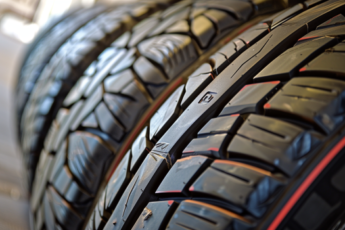Last Updated on 3 days
Discover the Importance of Tire Speed Rating and Make Informed Choices
Regarding your vehicle’s safety and performance, a crucial aspect often goes overlooked – your tire speed rating. Understanding this rating is vital for making informed decisions about the tires you choose for your vehicle. In this guide, we’ll delve into tire speed ratings, demystify their significance, and help you select the perfect tires for your needs.
Theoretically, a tire speed rating is the maximum sustainable speed at which the tire can safely carry a load over time in ideal conditions. This is generally represented by a letter on the sidewall of a tire. The letters on the sidewall of a tire typically range from “L” to “Y” – with each letter representing a different maximum speed.
It’s important to note that a tire’s speed rating is not a measure of its durability or longevity – as a tire with a higher speed rating may wear out faster than a tire with a lower speed rating if driven at high speeds regularly. The speed rating does not measure the tire’s load-carrying capacity; we have the tire load index.
Why Does Tire Speed Rating Matter?
- Safety First: Tire speed ratings aren’t just arbitrary numbers; they’re directly related to the tire’s construction and ability to dissipate heat generated during high-speed travel. Using tires with a lower speed rating than recommended can result in overheating and, ultimately, tire failure.
- Optimal Performance: Matching your tires’ speed rating with your vehicle’s top speed capability ensures you’ll experience the best possible handling and performance. It’s all about maximizing your driving experience.
- Legal and Insurance Considerations: In some regions, using tires with a lower speed rating than recommended for your vehicle might be illegal. Moreover, in an accident, insurance companies may scrutinize whether your tires met or exceeded the manufacturer’s recommendations.
How the speed ratings are measured
The rating is based on controlled lab conditions wherein the tire is subjected to heat and speed tests. The tests are designed to push the tire to its limit to measure its performance under extreme conditions. During these tests, the tires are inspected for failures – if none are detected, they pass the speed rating it was tested for.
In the real world, however, the speed rating may be less than the actual speed you can safely drive because of other factors, such as tire air pressure, the road surface, and the type of load your vehicle carries.
What Is a Tire Speed Rating?
Simply put, a tire speed rating is a code that indicates the maximum speed capability of a tire. It’s usually represented by a letter found on the tire’s sidewall. This letter corresponds to a specific speed range, and it’s crucial to match this rating with your vehicle’s capabilities and driving habits.
The most common tire speed rating system is based on miles per hour and goes from L (the lowest rating) up to Y (the highest) — see below:
Here’s a quick reference to standard tire speed rating codes
- N: Up to 87 mph (140 km/h)
- P: Up to 93 mph (150 km/h)
- Q: Up to 99 mph (160 km/h)
- R: Up to 106 mph (170 km/h)
- S: Up to 112 mph (180 km/h)
- T: Up to 118 mph (190 km/h)
- U: Up to 124 mph (200 km/h)
- H: Up to 130 mph (210 km/h)
- V: Up to 149 mph (240 km/h)
- W: Up to 168 mph (270 km/h)
- Y: Up to 186 mph (300 km/h)
- (Y) or (ZR): Exceeding 186 mph (300 km/h)
Most common tire speed ratings:
- For Sedans and light trucks: S and T
- For passengers, coupes, and sports cars (and some light trucks): N, P, Q, and R (for light trucks)
- For high-performance cars and some EVs, V, W, and Y
It’s important to note that the speed rating of a tire only applies when it is brand new. Once a tire has been used, its actual speed rating starts to degrade, and it can no longer be driven at those high speeds without sustaining damage. Thus, you must check your tires before going on a long road trip—even if they’ve been rated for high speeds in the past.
The speed rating chart (matrix) for tires:
What Happens if I Use a Tire with a Lower Speed Rating?
Lower-speed tires are used on off-road vehicles, while higher-speed tires are usually found on passenger cars and some light trucks. Also, the speed rating of a tire must be equal to or greater than the top speed rating of the vehicle.
If you use a tire with a lower rating than what your car is rated for, you will be at risk because those tires won’t handle the speeds your vehicle can reach. Using lower-rated tires could lead to blowouts or other accidents if you’re not careful. In short, it’s always best to use tires with at least the same speed rating as your car – preferably higher.
Always be sure to use the prescribed tires with the correct speed rating.
While the speed rating may give you an idea of how fast your tires can theoretically go, many other factors come into play when determining how quickly you can drive these. Be warned that if you subject your tires to faster speeds than their rated speed, you risk damaging them, causing safety issues and possibly an accident. For more information on tire safety and your tire needs, check our website or contact us so we can assist you.
How to Find Your Vehicle’s Recommended Speed Rating?
To determine your vehicle’s recommended tire speed rating, refer to your owner’s manual or the placard on the driver’s side door jamb. It’s essential to adhere to these recommendations to ensure both your safety and the longevity of your tires.
Selecting the Right Tires for Your Needs
Now that you understand the importance of tire speed ratings, it’s time to make an informed decision when purchasing new tires. Here are some key takeaways:
- Always match your tire’s speed rating with your vehicle’s recommended rating.
- Consider your driving habits and typical driving conditions when choosing tires.
- Consult with a tire professional or refer to your vehicle’s documentation for specific recommendations.
Conclusion
Your vehicle’s performance and safety depend on many factors, and one crucial element is often overlooked – tire speed ratings. By understanding these ratings, you can make informed choices regarding your tires. Knowing your tire’s speed rating is essential for a smooth and safe ride, whether you’re a daily commuter or an adventure seeker.
Ready to find the perfect tires for your needs? Shop Now at Giga Tires
Make the smart choice for your vehicle’s safety and performance. Buy from the best tire shop today.
At Giga Tires, we understand the significance of tire speed ratings and are here to help you make the right choice. Please browse our extensive selection of tires, all with clear speed rating information, to find the perfect match for your vehicle. Don’t compromise on safety or performance. Upgrade your tires today and experience the difference with Giga Tires!
Are you eager for more tire tips and tricks? Giga Tires has you covered. Please explore our website for a treasure trove of articles.
- Air Tire Pressure Mastery: 5 Essential Tips For Your Vehicle’s Vital Lifeline
- Unlocking The Mysteries Of Tire Symbols: Discover The Meaning Behind Tire Numbers With Confidence
- New Winter Tires Mastery: Your Indispensable Companion For The 2021-2022 Season
FAQs
What is tire speed rating?
Tire speed rating, represented by a letter on the tire’s sidewall (e.g., H, V, T), indicates the maximum speed a tire can safely handle. This rating ensures your tires match your vehicle’s capabilities and driving habits.
What determines a tire’s speed rating?
Tire speed ratings are determined through rigorous testing by manufacturers. Factors like tire construction, materials, and performance under specific conditions are considered. They choose a speed rating that matches or exceeds your vehicle’s top speed capability.
What happens if you exceed a tire’s speed rating?
Exceeding a tire’s speed rating can lead to reduced tire performance, increased risk of blowouts, and compromised safety. It’s essential always to match your tires’ speed rating with your vehicle’s capabilities to ensure safe driving.
What is the 100T rating on tires?
When properly inflated and maintained, a tire with a 100T rating is designed to handle speeds up to 118 mph (190 km/h). This rating is commonly found on tires for sedans and standard passenger vehicles. However, always check your vehicle’s specifications and manufacturer recommendations to ensure compatibility.










